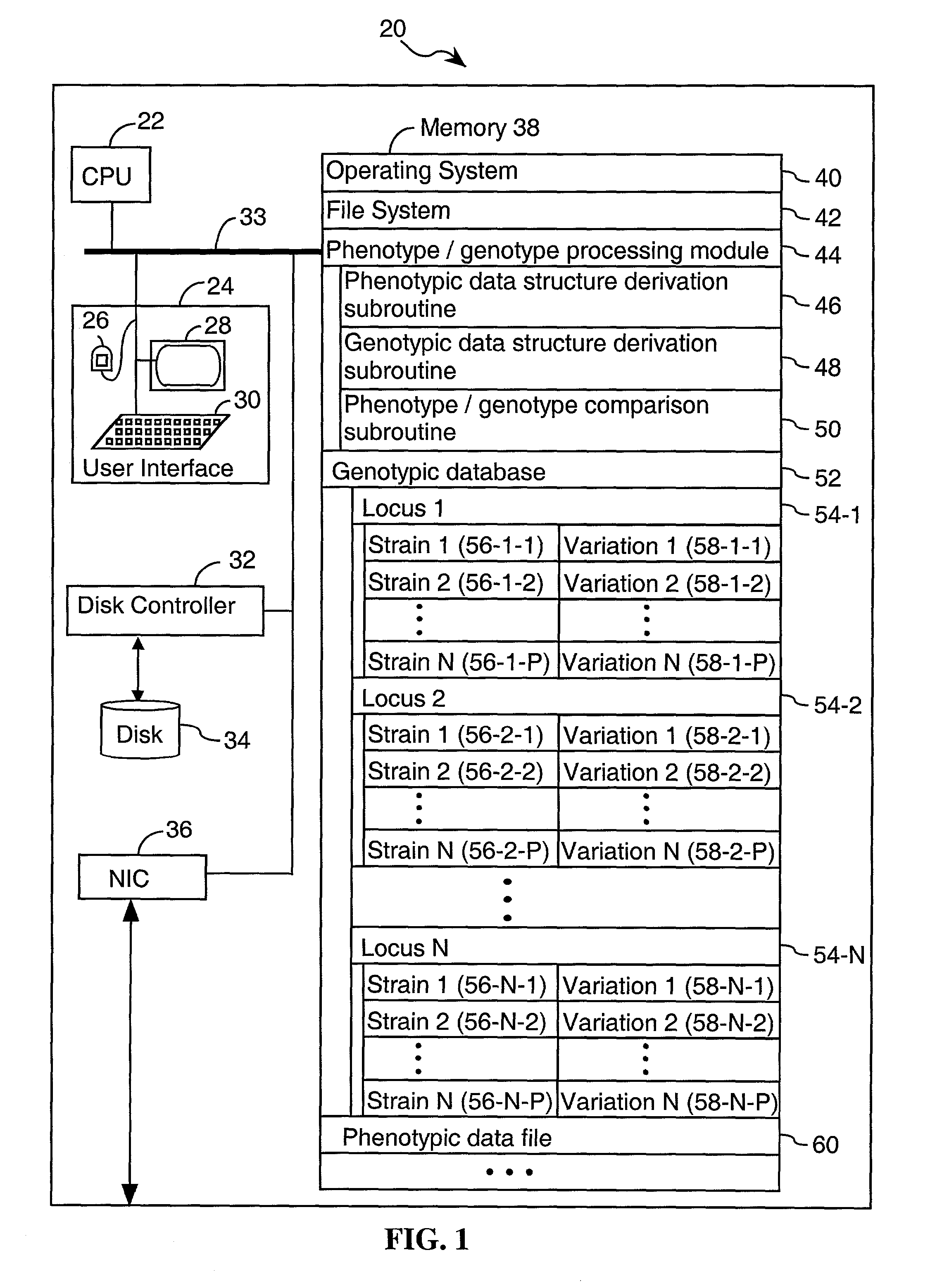System and method for predicting chromosomal regions that control phenotypic traits
a chromosomal region and prediction system technology, applied in the field of system and method for predicting chromosomal regions that control phenotypic traits, can solve the problems of difficult identification of common disease susceptibility loci, hampered mapping of disease susceptibility genes in human populations, and relatively limited progress in identifying genetic susceptibility loci for complex diseases using murine models
- Summary
- Abstract
- Description
- Claims
- Application Information
AI Technical Summary
Benefits of technology
Problems solved by technology
Method used
Image
Examples
example 1
[0153]Hypothetical example of the method for prediction of QTL regions. To aid in the understanding of the methods of the present invention, FIG. 3 is provided. FIG. 3 shows hypothetical comparisons, in accordance with the methods of the present invention, between three mouse strains (A, B, C) using SNP information found in the murine SNP database. Each of the two chromosomes sets for a given mouse strain is represented by a horizontal box along the horizontal axis of FIG. 3. Each chromosome set is characterized by the hatching type (horizontal, diagonal, and vertical). Chromosomes with the same hatching style in each of the mouse strains are identical. Cross hatched or diagonally hatched ovals respectively represent alleles at specific chromosomal positions. A dashed horizontal line is used to differentiate each of the mouse strains and the accompanying chart at the bottom of FIG. 3.
[0154]In the hypothetical example provided in FIG. 3, two of the three strains, (A) and (B), exhibit...
example 2
[0156]Predicting the chromosomal location of the MHC complex. The methods of the present invention were used to predict the chromosomal location of the MHC complex, which has been mapped to murine chromosome 17, using the H2 haplotypes for the MHC K locus for 10 inbred strains (Anonymous, JAX Notes 475, 1998). Phenotypic distances for strains that shared a haplotype were set to zero, and a distance of one was used for strains of different haplotypes. The SNPs within and near the MHC region had a genotypic distribution which was highly correlated with the phenotypic distances; the correlation value for interval 440 (FIG. 4A) was 5.35 standard deviations above the average for all loci analyzed. There were no other peaks throughout the mouse genome that exhibited a comparable correlation with the phenotype. The computational analysis, executed in accordance with the methods of the present invention, excluded 96% of the mouse genome from consideration without missing the genomic region ...
example 3
[0157]Identification of the QTLs that correspond to allergic asthma. The chromosomal positions that regulate susceptibility to experimental allergic asthma have been investigated using prior art techniques. For example, published analyses of intercross progeny between susceptible (A / J) and resistant (C3H / HeJ) mouse strains identified QTL intervals on chromosomes 2 and 7 (Ewart, et al., Am J Respir Cell Mol Biol 23, 537-545, 2000; Karp, et al., Nature Immunology 1, 221-226, 2000). The ability of the methods of the present invention to identify these chromosomal regions was investigated.
[0158]The phenotypic distance used to populate the phenotypic matrix was the absolute difference between the measured airway response after allergen-challenge for each strain pair. The experimentally identified QTL intervals on chromosomes 2 and 7 were among the strongest peaks identified by the methods of the present invention (FIG. 4B). The computational method excluded 80% of the mouse genome from c...
PUM
| Property | Measurement | Unit |
|---|---|---|
| Volume | aaaaa | aaaaa |
| Volume | aaaaa | aaaaa |
| Volume | aaaaa | aaaaa |
Abstract
Description
Claims
Application Information
 Login to View More
Login to View More - R&D
- Intellectual Property
- Life Sciences
- Materials
- Tech Scout
- Unparalleled Data Quality
- Higher Quality Content
- 60% Fewer Hallucinations
Browse by: Latest US Patents, China's latest patents, Technical Efficacy Thesaurus, Application Domain, Technology Topic, Popular Technical Reports.
© 2025 PatSnap. All rights reserved.Legal|Privacy policy|Modern Slavery Act Transparency Statement|Sitemap|About US| Contact US: help@patsnap.com



